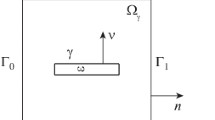Abstract
Under consideration is a 2D-problem of elasticity theory for a body with a thin rigid inclusion. It is assumed that there is a delamination crack between the rigid inclusion and the elastic matrix. At the crack faces, the boundary conditions are set in the form of inequalities providing mutual nonpenetration of the crack faces. Some numerical method is proposed for solving the problem, based on domain decomposition and the Uzawa algorithm for solving variational inequalities.We give an example of numerical calculation by the finite element method.
Similar content being viewed by others
References
G. P. Cherepanov, Mechanics of Brittle Fracture (Nauka, Moscow, 1974; McGraw-Hill, New York, 1979).
N. F. Morozov, Mathematical Problems of Crack Theory (Nauka, Moscow, 1984) [in Russian].
A. M. Khludnev, Elasticity Problems in Nonsmooth Domains (Fizmatlit, Moscow, 2010) [in Russian].
A. M. Khludnev and V. A. Kovtunenko, Analysis of Cracks in Solids (WIT-Press, Southampton, Boston, 2000).
E. M. Rudoy, “Domain DecompositionMethod for aModel Crack Problem with a Possible Contact of Crack Edges,” Zh. Vychisl. Mat. Mat. Fiz. 55 (2), 310–321 (2015) [Comput. Math. and Math. Phys. 55 (2), 305–316 (2015)].
E. Rudoy, “Domain Decomposition Method for Crack Problems with Nonpenetration Condition,” ESAIM: M2AN, DOI: 10. 1051/m2an/2015064 (2015).
V. A. Kovtunenko, “Numerical Simulation of the Nonlinear Crack Problem with Nonpenetration,” Math. Meth. Appl. Sci. 27 (2), 163–179 (2004).
M. Hintermüller, V. Kovtunenko, and K. Kunisch, “The Primal-Dual Active SetMethod for a Crack Problem with Nonpenetration,” IMA J. Appl. Math. 69 (1), 1–26 (2004).
E. V. Vtorushin, “Numerical Investigation of a Model Problem for the Poisson Equation with Inequality Constraints in a Domain with a Cut,” Sibirsk. Zh. Industr. Mat. 8 (1), 41–49 (2005) [J. Appl. Indust. Math. 2 (1), 143–150 (2008)].
V. M. Aleksandrov, B. I. Smetanin, and N. G. Sobol’, Thin Stress Concentrators in Elastic Solids (Fizmatlit, Moscow, 1993) [in Russian].
L. T. Berezhnitskii, V. V. Panasyuk, and N. G. Stashchuk, Interactioin of Rigid Linear Inclusions and Cracks in a Deformable Solid (Naukova Dumka, Kiev, 1983) [ Russian].
A. M. Khludnev and G. Leugering, “Optimal Control of Cracks in Elastic Bodies with Thin Rigid Inclusions,” Z. Angew. Math. Mech. 91, 125–137 (2011).
A. M. Khludnev and G. Leugering, “On Elastic Bodies with Thin Rigid Inclusions and Cracks,” Math. Meth. Appl. Sci. 33, 1955–1967 (2010).
E. M. Rudoy, “Invariant Integrals in a Planar Problem of Elasticity Theory for Bodies with Rigid Inclusions and Cracks,” Sibirsk. Zh. Industr. Mat. 15 (1), 99–109 (2012) [J. Appl. Indust. Math. 6 (3), 371–380 (2012)].
E. M. Rudoy, “Shape Derivative of the Energy Functional in a Problemfor a ThinRigid Inclusion in an Elastic Body,” Z. Angew. Math. Phys. 66 (4), 1923–1937 (2015).
E. M. Rudoy, “First-Order and Second-Order Sensitivity Analysis for a Body with a Thin Rigid Inclusion,” Math. Meth. Appl. Sci., DOI: 10. 1002/mma. 3332 (2015).
V. V. Shcherbakov, “On an Optimal Control Problem for the Shape of Thin Inclusions in Elastic Bodies,” Sibirsk. Zh. Industr. Mat. 16 (1), 138–147 (2013) [J. Appl. Indust. Math. 7 (3), 435–443 (2013)].
V. V. Shcherbakov, “On Selection of Optimal Shape of Thin Inclusions in Elastic Bodies,” Prikl. Mekh. Tekhn. Fiz. 56 (2), 178–187 (2015).
H. Itou, A. M. Khludnev, E. M. Rudoy, and A. Tani, “Asymptotic Behaviour at a Tip of a Rigid Line Inclusion in Linearized Elasticity,” Z. Angew. Math. Mech. 92 (9), 716–730 (2012).
D. Bigoni, F. Dal Corso, and M. Gei, “The Stress Concentration near a Rigid Line Inclusion in a Prestressed, Elastic Material. Part II. Implications on Shear Band Nucleation, Growth and Energy Release Rate,” J. Mech. Phys. Solids 56, 839–857 (2008).
F. Dal Corso, D. Bigoni, and M. Gei, “The Stress Concentration near a Rigid Line Inclusion in a Prestressed, ElasticMaterial. Part I. Full-Field Solution and Asymptotics,” J. Mech. Phys. Solids 56, 815–838 (2008).
R. A. Chaudhuri, “On Three-Dimensional Singular Stress/Residual Stress Fields at the Front of a Crack/Anticrack in an Orthotropic/Orthorhombic Plate under Anti-Plane Shear Loading,” Comp. Struct. 92, 1977–1984 (2010).
A. Quarteroni and A. Valli, Domain DecompositionMethods for Partial Differential Equations (Clarendon Press, 1999).
Yu. M. Laevsky and A. M. Matsokin, “Domain Decomposition Methods for Solving Elliptic and Parabolic Boundary Value Problems,” Sibirsk. Zh. Vychisl. Mat. 2 (4), 361–372 (1999).
G. P. Astrakhantsev, “Domain-Decomposition Method for the Problem of Bending Heterogeneous Plate,” Zh. Vychisl. Mat. Mat. Fiz. 38 (10), 1758–1766 (1998) [Comput. Math. and Math. Phys. 38 (10), 1686–1694 (1998)].
A. V. Rukavishnikov, “Domain Decomposition Method and Numerical Analysis of a Fluid Dynamics Problem,” Zh. Vychisl. Mat. Mat. Fiz. 54 (9), 1515–1536 (2014) [Comput. Math. and Math. Phys. 54 (9), 1459–1480 (2014)].
G. Bayada, J. Sabil, and T. Sassi, “Convergence of a Neumann–Dirichlet Algorithm for Two-Body Contact Problems with Nonlocal Coulomb’s Friction Law,” ESAIM:Math. Model. Numer. Anal. 42, 243–262 (2008).
I. Ekeland and R. Temam, Convex Analysis and Variational Problems (SIAM, 1999).
K. Ito and K. Kunisch, LagrangeMultiplier Approach to Variational Problems and Applications (SIAM, 2008).
A. M. Khludnev, “Thin Rigid Inclusions with Delaminations in Elastic Plates,” European J. Mech. A/Solids 29, 69–75 (2010).
Yu. N. Rabotnov, Mechanics of Deformable Solids (Nauka, Moscow, 1988) [in Russian].
G. Allaire, Numerical Analysis and Optimization: An Introduction to Mathematical Modelling and Numerical Simulation (Univ. Press, Oxford, 2007).
Ph. Ciarlet, The Finite Element Method for Elliptic Problems (North-Holland, Amsterdam, 1978; Mir, Moscow, 1980).
Author information
Authors and Affiliations
Corresponding author
Additional information
Original Russian Text © E.M. Rudoy, 2016, published in Sibirskii Zhurnal Industrial’noi Matematiki, 2016, Vol. XIX, No. 2, pp. 74–87.
Rights and permissions
About this article
Cite this article
Rudoy, E.M. Numerical solution of an equilibrium problem for an elastic body with a thin delaminated rigid inclusion. J. Appl. Ind. Math. 10, 264–276 (2016). https://doi.org/10.1134/S1990478916020113
Received:
Published:
Issue Date:
DOI: https://doi.org/10.1134/S1990478916020113



